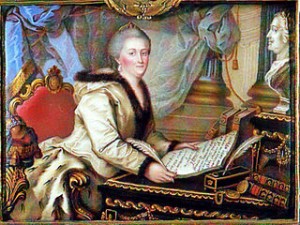Catherine establishes many new reforms for establishing the bureaucracy as well as containing the power of the nobility. With the military commanders set up by Peter the Great removed after his death, Catherine establishes a new system for governing the massive expansion of land that is Russia. She appoints the leaders for these provinces, so they are loyal to her and thereby she centralizes her power. What makes these reforms Enlightened however are the responsibilities she gives to these governors, as well as the fact that she is writing all of these, taking an active role in her governance. These administrations are expected to establish welfare systems, build bridges and roads for the people, as well as education, orphanages, and poor houses. ((Kaiser, Daniel H. and Gary Marker. Reinterpreting Russian History: Readings 860-1860s. New York: Oxford University Press, 1994. 242)) It was not simply just a way for her to control Russia, but she reflects what Peter did in establishing things for the good of the Russian people, not only her own power. The Enlightenment ideals that clearly had a hold on Catherine’s mind are shown here as she seeks to educate her people, and take care of them but also the absolutist ideals of autocratic rule. The picture shown at the bottom demonstrates how Catherine wanted people to know that she was actively involved in the process of writing the law as well as enforcing it.
Catherine demonstrates a tremendous amount of skill by allowing the nobles to have a small amount of power and in return she stays on the throne. ((Kaiser 245)) Her vision of uniting Russia under her rule to become a more educated state, as well as one that took care of it’s people is shown in her law codes and charters. While she undoubtedly put many people in serfdom, she sees the majority of this going towards the glory of the state. By establishing schools and a welfare system throughout the country, she is making Petersburg closer to everyone through a more progressive way. This is truly enlightened as she realizes that Russia must move forward, but she also preserves many of the traditions as she knows her legitimacy is shaky.
How does her vision compare and contrast with the vision of Peter the Great?
 https://commons.wikimedia.org/wiki/File:Catherine_2_nakaz.JPG
https://commons.wikimedia.org/wiki/File:Catherine_2_nakaz.JPG
